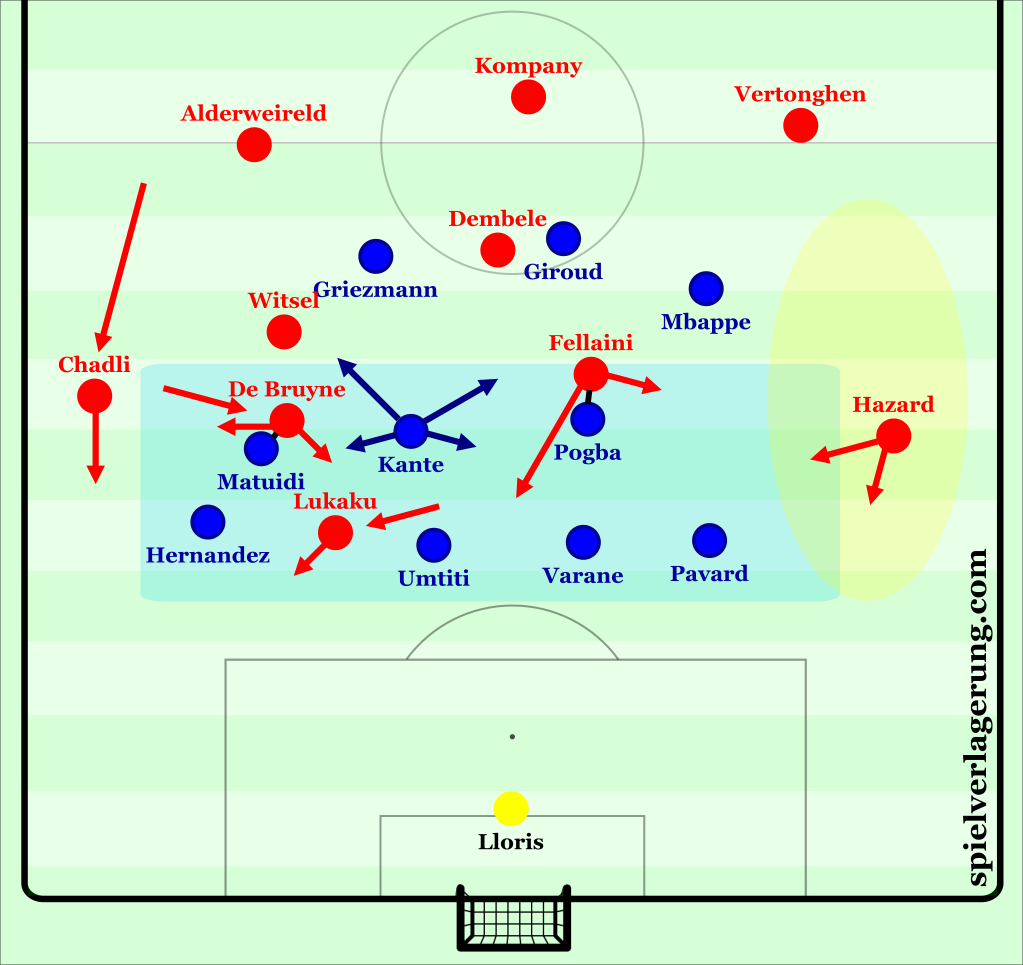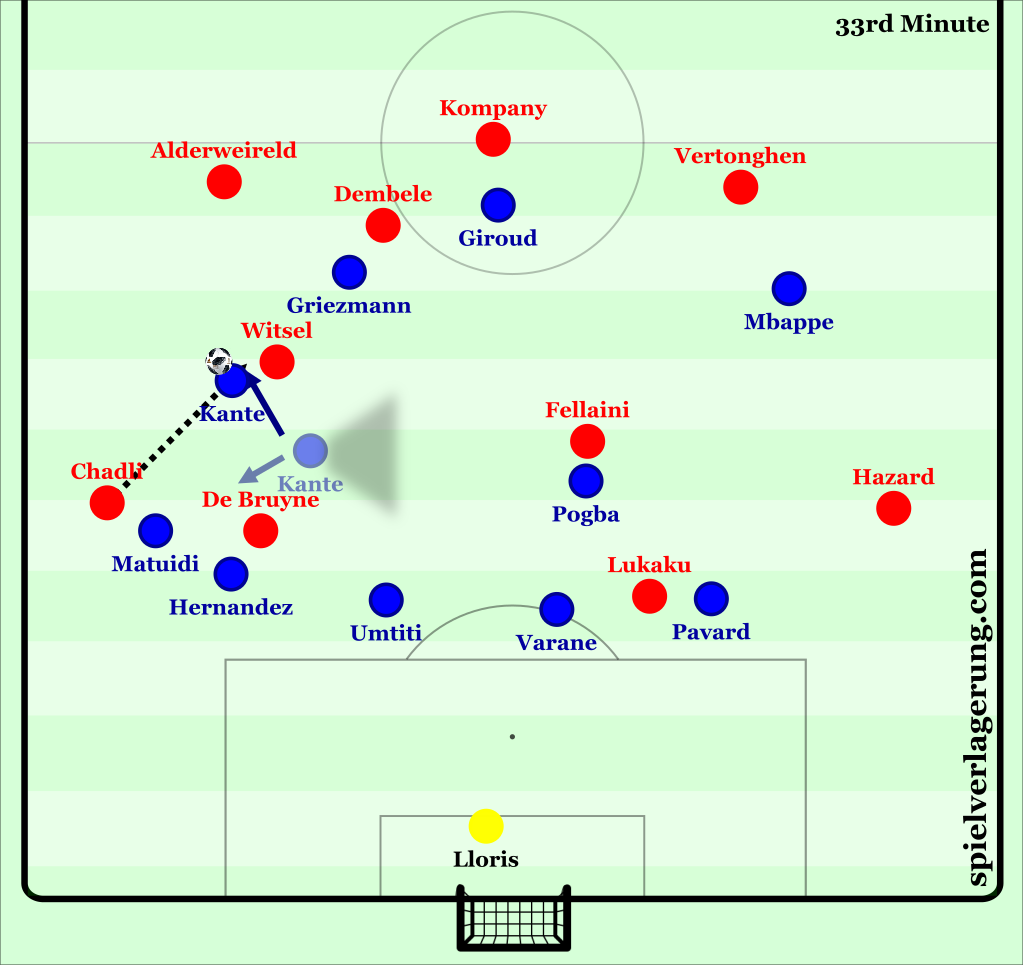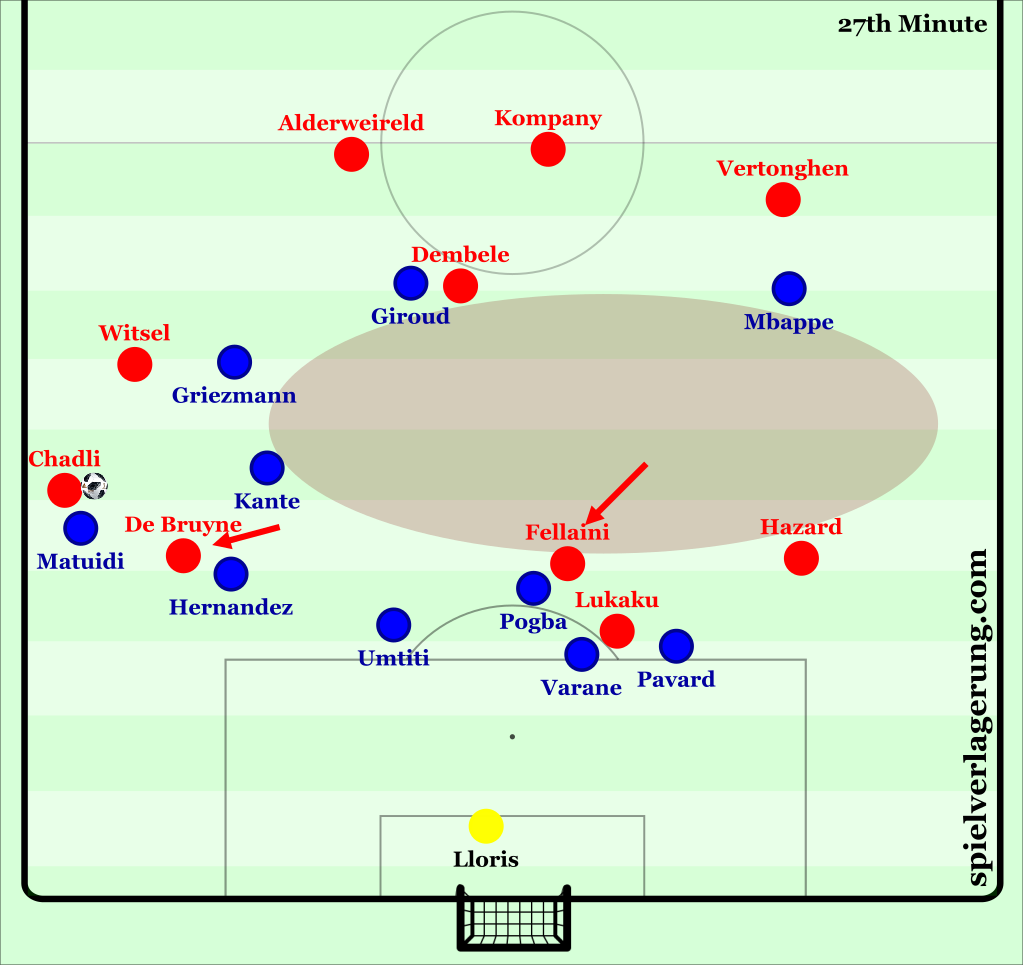ワールドカップが終わり、試合の分析記事も出揃ってきています。
spielverlagerungより、準決勝のフランスVSベルギーの分析記事がアップされていました。結果はセットプレーの得点による1-0と点数自体の動くは大きく無かったものの、内容自体は互いの戦術がぶつかりある濃い試合だったようです。
以下本文になります。
Semifinals: France 1-0 Belgium
A game of two states. Before the lone goal of the match, it was a tactically dynamic affair with several notable aspects surrounding possession behavior, team tactical mechanisms in transition, and high intensity defensive executions from both teams. After the French took the lead, the Belgians veered from their original focus in search of an equalizer. France were able to absorb Belgium’s attack and earn their spot in the World Cup Final.
準決勝 フランス1ー0ベルギー
ゲームには2つの状態がありました。この試合の唯一の得点が記録されるまで、ボール保持の振る舞いによっていくつか注目すべき様相を見せ、戦術的にダイナミックな動きを起こしていました。両チーム共に守備では高いインテンシティを保ち、攻守の切り替えの場面では戦術的なメカニズムを持っていました。フランスがリードするとベルギーは同点にするべく、彼らの元々の狙いからは逸脱するようになります。フランスはベルギーの攻撃をいなして決勝へと駒を進めました。
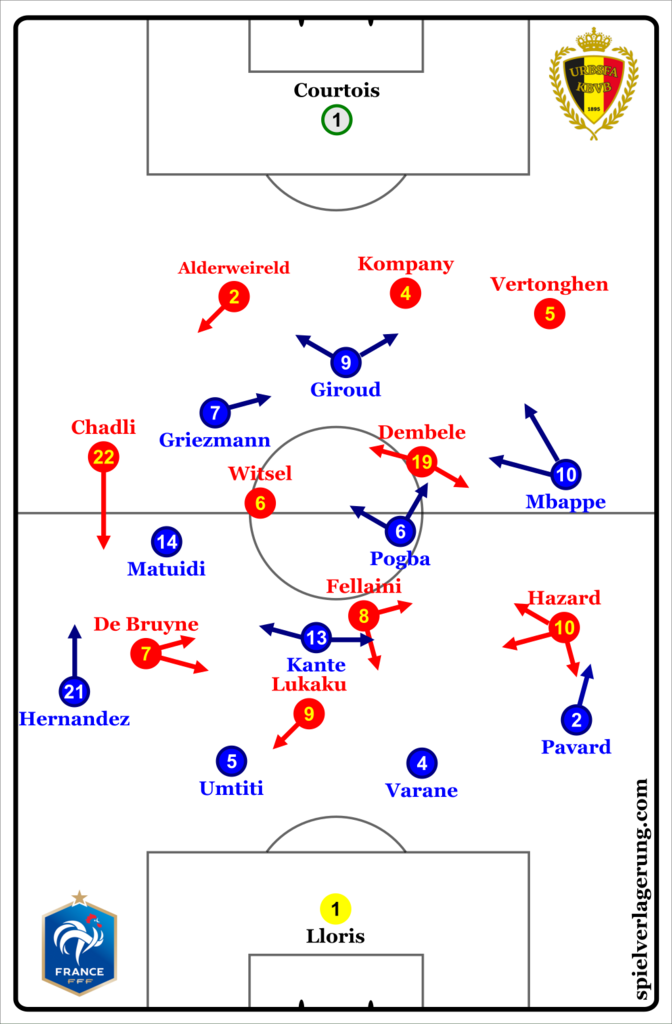
We previewed this matchup in the most recent episode of the SV Podcast, where the common discussion themes were about what manager Roberto Martinez could do to possibly gain an edge against the French. Considering Didier Deschamps’ team is so difficult to beat, several possibilities were mentioned about how to best them, and Martinez managed to somehow blend in all of them into the match.
France have rarely made monumental shifts to their playing style throughout the tournament, with small opponent specific tendencies and alterations in midfield being the predominate adjustments from match to match. As expected, Deschamps set up his team around a stable focus in central areas, with transitions being a key focus of their attacking play. The one change in the team that Deschamps made was to insert Matuidi for Tolisso, continuing their hybrid 4-3-3/4-2-3-1 shape utilized throughout their Russian mission.
最新のポッドキャストでこの試合のプレビューをしたのですが、話題のほとんどはロベルト・マルチネスはフランスに対してサイドで優位を取ってくるだろうという事でした。ディディエ・デシャンのチームを倒すのはとても難しく、ベストな方法についてはいくつかの可能性が述べられました。この試合でマルチネスはなんとか全てを落とし込んでいました。
フランスはトーナメントを勝ち抜くためにプレースタイルを変えることは無いでしょう。ここまで対戦相手の傾向によって中盤を変更するくらいの調整でした。予想通り、デシャンは中央での安定性に焦点をあてたスタメンにしました。攻撃の鍵になるのはトランジションです。変わった所はトリッソをマチュイディに変更したぐらいで、ロシアの地で勝ち抜くために、4-3-3-と4-2-3-1を融合させたようなシステムを構成しました。
For Belgium, they made a couple of changes from their victory over the favoured Brazilians. Meunier was out of contention because of yellow card accumulation, causing Martinez to adjust his team yet again. In terms of names, Mousa Dembele was the only change. However, Belgium once again had a metamorphic system of play in this game. While in the last match it was a base of a 4-3-3, this match had a slight tweak into a 4-2-3-1. Nacer Chadli functioned as a makeshift right back, as Witsel and Dembele worked in a double pivot. Fellaini operated as a ten, doubling the aerial presence in central areas for the Red Devils.
ベルギー代表はブラジルに勝利したメンバーから少し変更がありました。ムニエが累積警告で出られなかったので、監督のマルティネスは再びチームを調整する必要があります。メンバーで変更があったのはムサ・デンベレだけです。ただし、ベルギーはこの試合のためにまたしてもシステムを変形させてきました。最新の試合は4-3-3を基盤としていまたが、この試合では4-2-3-1と微妙に変更を行いました。ナセル・シャドゥリが右後方に移り、ヴィツェルとデンベレによるダブルボランチです。フェライニは10番として扱われ、赤い悪魔が中央で制空権をとるねらいです。
Belgium shifts with the ball
The most predominant feature of Belgium’s system throughout the match was the metamorphosis the team underwent in possession. Considering France were oriented in a passive deep block, Belgium were able to manage a majority share of possession and implement their noticeable shifts in possession.
ボールを持ったベルギーの変化
試合を通してベルギーのシステムに見られた顕著な特徴は、ボールを持った時の変形です。フランスは低く守備ブロックを構える傾向にある事を考慮すると、ベルギーはボール保持を試合の大半で取れることができるのでこの様な変形が実現されました。
Belgium’s attacking shape worked as follows: Chadli moved high from his starting fullback position to occupy the right wing, with De Bruyne correspondingly moving into the right halfspace in the same vertical line as him. Witsel and Dembele occupied the spaces directly in front of the remaining three chain for central stability and horizontal circulation purposes. Fellaini mainly took up the left halfspace, venturing into the forward line when Lukaku roamed into the right channels. Hazard started out based on the left touchline. Thus in possession, a 3-2-4-1 formed with some small situational shifts which will be expanded on shortly.
ベルギーの攻撃では次の様に動かしていました。シャドゥリはスタートポジションの右SBから高い位置に移動して右サイドに張ります。同じ右サイドにいたデ・ブライネはそれに応じて右ハーフスペースに移動します。中央の安定性と水平方向へのボール回しを円滑にするため、ヴィツェルとデンベレは残りの三人のDFの前方に位置します。フェライニは大半を左ハーフスペースに位置して、ルカクが右に移動すると思い切って前に出ていきます。アザールは左サイドのタッチラインの側をスタートポジションとしていました。ボール保持ではこのように少しの変化で3-2-4-1の形を取っていました。
With France’s deep block, the front three dropped off of the centre backs in preference of covering midfield passing options as opposed to proactively pressing during Belgium’s first phases. This 4-3-3-0 was heavily stacked in the centre of midfield, limiting the exposure to the ball of Belgium’s key players in highly beneficial areas.
フランスの低いブロックは、前線の3人がポジションを下げることで中盤へのパス選択肢を消していました。ベルギーの前線がプレスをかけていたのとは対称的です。この4-3-3-0システムは中盤の中央に厳しい密集をつくり、高い位置でのベルギーのキープレイヤーのボールに制限をかけていました。
As a result, much of Belgium’s attacks in the match were originated from the wings, each with a differing respective profile. Along the back line in possession, the superior distributors were the side backs of Vertonghen and Alderweireld, so in terms of their organization and progression of attacks, this development is logical. From the left side, Vertonghen was able to play diagonally toward the wing into Hazard, as France’s defensive positional focus was just central enough so that both Mbappe and Pavard did not have suitable access to Hazard when on the edge of the touchline.
結果としてベルギーの攻撃の大半は異なる特長をもつサイドの選手から作られていました。DFラインでボールを持っている時にはフェルトンゲンとアンデルヴェイレルドがサイドバックの様になり、優れた配球者となっていました。組織としてこの攻撃手法はロジカルです。左サイドからフェルトンゲンはウイングのアザールに向けて斜めにプレーでき、フランスの守備の焦点は中央に向けられていたので、エンバペとパバールの二人はタッチライン際にいるアザールにつくことが出来ませんでした。
Considering Pogba’s foreshadowing of the man-orientations on Fellaini in these opening stages, Hazard freely received these passes and progressed toward France’s goal through his exceptional dribbling, the most difficult task for France to contain on the night. Considering his decision making is world class when surrounded by multiple defenders, the onus was on Varane and Umtiti to cope with the subsequent actions that came after Hazard’s penetration, successful in their timing and application of clearances, even if it appeared precarious in the penalty area.
開始直後にポグパがフェライニにマンマークしていた事が伏線となり、アザールはフリーでボールを受けられてその並外れたドリブルでフランスのゴールに向かいます。フランスによって最も困難な状況です。複数で囲まれた時のアザールの決断力がワールドクラスである事を考慮すると、アザールがゴール前に侵入した来た後の対処はヴァランとウンティティに頼っていました。ペナルティーエリアの中でさえ、彼らのタイミングとカバーにより守備を成功させていました。
The right side of Belgium’s attack took a different disposition in terms of the collectivism of the tactics. Alderweireld more frequently dribbled out of the defensive line, causing Belgium’s attack to become predominately focused down this side. The circulation amongst Chaldi, De Bruyne, and Witsel against France’s passive block had considerable success when it was exclusively the three of them. With France wanting to press in the wings at first – Hernandez closed off the halfspaces in isolated situations to attempt to win the ball during individual duels – Chadli was able to get past Hernandez to put crosses into the penalty area. Fellaini then ran diagonally toward the centre to contest these crosses, which failed in execution but revealed Belgium’s early focus and tendencies.
グループ戦術という観点から、ベルギーの右サイドは 異なる性質を持っていました。アンデルヴェイレルドはDFラインから頻繁にドリブルで持ち上がり、それによってベルギーの攻撃はサイドにねらいをつける様になりました。フランスの敷いた守備陣形に対して、シャドゥリ、デ・ブライネ、ヴィッツェルはポジションを循環させることで攻撃をうまく成功させていました。フランスとしては最初にウイングがプレスを掛けようとして、エルナンデスは孤立した状況でハーフスペースを封鎖し、個人のデュエルでボールを奪おうとしていました。そのためにシャドゥリはペナルティエリア付近に入り込んでクロスを上げることが出来ていました。フェライニはクロスに対して斜めに走り込んでいました。この攻撃は失敗に終わるのですが、試合が始まってからのベルギーの狙いは明らかでした。
Some of these attempts ended up with Hazard, who either recycled the attack or hazarded a scoring opportunity for himself. The early wing focus had the left side possess a more liberal means of progressing through the attack, with the right side being a bit more collective, yet still matching player strengths to the roles of the system well given the opponent.
これらの攻撃の試みは最終的にアザールに行き着いていました。波状攻撃をしかけたりアザールが自身で得点を狙うこともありました 。焦点を当てていた左サイドはボール保持からの攻撃に高い自由度を持っています。右サイドはより集団的で、システムとしての役割と選手の強みが一致していました。
France’s Learning; Belgian modifications
Despite the Belgian protagonism early on, France were able to make intelligent defensive adjustments in the flow of the match to counteract Belgium’s individual and structural potential. With Belgium’s ambitious on ball shape, they were able to commit more resources toward sequences in the final third of play, adequately covered thanks to a blend of France’s retreating and adequate occupation of each zone in attack.
フランスは理解する;ベルギーは変化する
序盤、ベルギーは試合を有利にすすめていました。ベルギーの個人と集団による可能性のある攻撃に対し、フランスは試合が進むに連れて守備陣形を調整する賢さをみせました。ベルギーは野心的なボール保持によりファイナルサードに多くのリソースをつぎ込む事が出来ていました。けれどもフランスは撤退守備とゾーンを埋める守備を組み合わせることで的確なカバーを行っていました。
Yet as the half wore on, the focus toward the right side of play gradually increased, given the passages between players moved the ball further into France’s half. France no longer primarily focused in pressing in the wing spaces, recognizing that they could bait Belgium toward the centre through not only successfully intercepting passes, but also have multiple players able to pressure in those central areas to trap their opponents.
右サイドでのプレーがだんだんと増えていくと、 フランス陣内に入るよりもむしろ選手間でボールが行き交うようになっていました。フランスはもはやサイドでのプレスを重要視していません。彼らはベルギーを中央におびき寄せてインターセプトを成功させるだけでなく、中央で罠をしかけて複数の選手によるプレスをかけることが出来ていました。
This situation increased in both complexity and difficulty to achieve as more players entered the right side for attacks. With Lukaku moving into the right halfspace as a possible bumper to the structure between Chadli and De Bruyne, so followed the man-orientation of Umtiti and a minor relocation of the remainder of the defensive line. This movement occurred as Hernandez moved to pressure Chaldi, rather than operating there as a starting reference. An action intended to promote combination play and more possible methods of breaking through France actually had the opposite outcome.
ベルギーが攻撃のために右サイドへ人をかけることによる複雑さと難しさの両方のせいでこの様な状況が増えていました。シャドゥリとデ・ブライネの間を取り持つようにルカクは右ハーフスペースに移動していました。ウムティティがそれにマンマークするためについていくと、DFラインの残りの選手はポジションを修正します。この動きは事前に用意されていたというよりは、むしろエルナンデスがシャドゥリにプレスに行ったことから起きていました。連携プレーや突破の可能性を広げようとするベルギーの一連の動きでしたが、実際には反対の結果になっていました。
The introduction of Lukaku to the scene permitted Umtiti and France to increase the extremity of their ball orientation, thus restricting the space for Belgium to actually play with on the right section of the pitch. Matuidi from here functioned in a man-oriented sense with De Bruyne, and Chadli dealt with by Hernandez correspondingly. After Belgium’s bright start to In terms of circulation, this left Axel Witsel free to progress play or even switch the point of attack. Until Kante arrived.
ルカクの動きにより、ウムティティとフランスはボール指向を強めてベルギーは右サイドでプレーするスペースを制限される事になりました。マチュイディのデ・ブライネに対するマンマークが機能して、エルナンデスはその動きに呼応してシャドゥリの対処にあたっていました。左ボランチのヴィッツェルはフリーでボールを進めたり攻撃の起点となることで、ベルギーはボール循環による攻撃を華々しく開始しました。けれども、それはカンテが登場するまでの話です。
A note about Kante, in what was perhaps his best match thus far for France. During this match, Kante positioned himself extremely well relative to his teammates, taking up positional blends between spots where he concurrently prevents dangerous balls being played in between his team’s lines or gaps between defenders, having access to 2-3 passing at once to either pressure or at least be the second man in coverage/pressing, and yet located himself in a spot where he invites the opponent to play the most simple easiest pass. And as the opponent plays it, Kante anticipated it with incredible speed and intercepts it. This ability to win these pass duels is the predominant feature to the design of France’s pressure throughout the knockout stages, and a key reason they are now through to to final.
In the times that Kante could not intercept Witsel’s passes, there were still some key consequences that came from Belgium’s one-sidedness in attack. Once Lukaku would move toward the ball, Belgium were caught in a difficult situation for chance creation, as the highest central figure in their team was now distant from getting onto any crosses or even diagonal passes from the wide zones. To replace this presence, Fellaini would move into the forward line, functioning as a makeshift target in the temporary absence of Lukaku.
But with that movement, Belgium’s attacking structure unbalanced. With Fellaini moving him, he simultaneously vacated an important section of the pitch for his team. When on the right side, there was now no central options (diagonal from the ball) that could connect one section of the team. Hazard remained toward the wing in his slot, thus leaving a large unoccupied territory between the highest player and the double pivot at the back of the team. This confined Belgium to stick toward one side when they were attacking, either failing to generate any chances down the right or losing possession in the midst of construction.
As the half went on, Hazard began to take up these central positions with Fellaini moving wide left, presumably to get Hazard’s dribbling ability in more dangerous areas to fashion opportunities. A solution that could’ve worked for Belgium was to simply have Hazard move inside as Fellaini moved higher. Considering France’s already deep block, moving another player into the centre increases the demands of the auxiliary defenders joining from the attacking line, having to process more player interactions and more complex defensive interactions. Width could be generated through late movements from Vertonghen, running onto passes later as the ball is transferred from side to side. With the double pivot, four players would be adequate to defend in rest defense against most teams.
前半が進むにつれて、フェライニは左サイドに移動してアザールは中央のポジションを取り始めました。 アザールのドリブル能力をより危険な場所で発揮させようとする狙いだろうと思われます。フェライニが高い位置とるのと同時にアザールが中に入るシンプルな形というのも、ベルギーの攻撃を機能させる一つの案です。フランスがすでに低い守備ブロックを作っていることを考えると、中央に人を増やすことは相手の攻撃の選手を守備に参加させることを要求して、より多くの選手が相互作用をとる複雑な守備を必要とさせます。フェルトンゲンの上がる動きにより幅を作り出し、ボールがサイドからサイドへと動くようになります。二人のボランチを加えた4人で守ることで大抵の相手にたいして十分に守ることができます。
Oh wait, Kylian Mbappe. Makes sense now why Belgium wouldn’t implement such a strategy.
ちょっと待ってください。ムバッペがいます。彼がいるおかげでどうしてベルギーがこのような戦略を実行しないのかが分かります。
While Belgium’s attack started brightly, France were shrewd in how they adjusted both individual tendencies and group tactics to nullify their opponents. Belgium’s collective attacking was a mixture of ambitious and somehow stale, breaking down once they met the deeper layers of France’s shield.
ベルギーの素晴らしい攻撃の間、フランスは相手を無効化するために個人の指向とグループ戦術の調整を行い、それは鋭敏な感覚でした。野心的でどこか古めかしさが混ざったようなベルギーの集団攻撃は、フランスの何層にも重ねられた盾の前に崩壊してしまいました。
Belgian Math: Minus the ball, adding in the centre
Considering all of the developments of Belgium in possession, their changes out of possession were equally impactful in the overall dynamics of the game. Chadli returned to the defensive line, with Witsel spanning the right halfspace and wing in territory. Dembele managed the area just behind Witsel alongside leftward coverage for Hazard, who (inconsistently) dropped centrally from the wing. Completing the puzzle, De Bruyne stepped higher to join Lukaku in situations where France preferred their left side to build up, getting Lucas Hernandez in higher positions in the process. Fellaini reciprocated the man-orienation applied onto him toward Pogba in the opening phases of France’s build up.
ベルギーの数学:ボールを減らすと中央に加える
ベルギーの攻撃の組み立てを振り返ると、ポゼッションを失うことはゲームに大きな影響を与えることになります。シャドリはDFラインにもどり、ヴィツェルは右サイドとハーフスペースにまたがる位置になります。サイドから(たまに)中央に降りてくるアザールが左方向を守るとともに、デンベレはヴィツェルの背後のスペースを管理します。このパズルが完成すると、ルーカス・エルナンデスが高くあがるフランスの左サイドからのビルドアップを防ぐためにデ・ブライネはルカクのように高い位置に上がります。フェライニはフランスが攻撃を組み立てるときにはポグバへのマンマークを繰り返し行っていました。
The ensuing picture for Belgium resulted in asymmetry in defense. It was 4-diamond-2 in some spells, 4-5-1 in others, 4-3-3, and so on. Regardless of the semantics, it was primarily concerned with a spatial focus on preventing passages into Griezmann to catalyze French attacks. Not to be overshadowed, another notable priority for Belgium was the pressing on the wings. Akin to their opponents, their narrow defensive structure provided ample space for France to pass toward their wide options.
結果としてベルギーが非対称の守備になっていたことを次の画像で示しています。4-4-2ダイヤモンド型、4-5-1、4-3-3などと表現されていました。システムなどはおかまいなしで、主にフランスの攻撃の触媒であるグリーズマンへのパスコースを消すことに焦点を当てていることに関係しています。それが他に影響を与えないということはありません。サイドにプレスをかけるというもう一つの優先課題がベルギーにはあります。相手と同様にベルギーの狭い守備組織はフランスにサイドへの十分なパスコースを与えることになります。
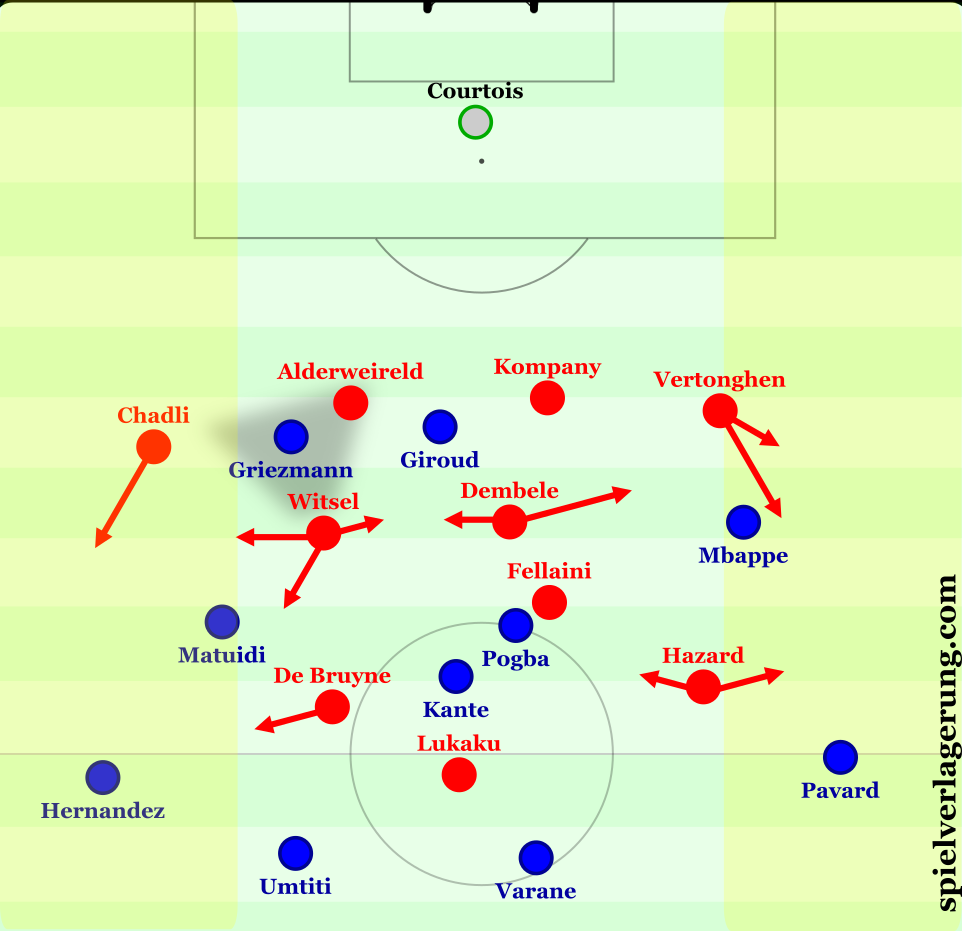
Belgium’s defensive pressing movements with strategic emphasis on preventing Griezmann from receiving the ball and pressing toward the wings with support from the central midfielders.
Avenues were then available for the fullbacks to become more involved in attacking developments. From the centre backs, these passes into Pavard however were readily anticipated by Vertonghen, using the possession of fullbacks moving forwards as a cue to step up as fullbacks to intercept the ball in its flight if possible. Lucas Hernandez, superior in his timing of these movements, evaded these by starting runs later and moving into mixed spaces between lines during the pass rather than before it is played.
そうしてフランスのサイドバックが攻撃により関与させる道が出来上がっていました。しかしながら、センターバックからパバールへのパスはフェルトンゲンによって予防されていました。可能性としてボールを奪うことによってサイドバックが前方にでるきっかけとなります。エルナンデスはこの動きのタイミングのとり方に優れていました。走り出すこととライン間でパスを受けるポジションニングを巧みに混ぜ合わすことで、パスをカットされるのを防いでいました。
France’s attack composition, as unsystematic as it can be, followed the trendline for the last few matches. Pavard and Mbappe working in tandem on the right, with Hernandez being the primary source of width on the left. With these tendencies in mind, the Belgian central midfielders were instrumental figures to limiting the influence of these wide players. Dembele and Witsel frequently stepped toward wide areas as supporting pressure for the fullbacks to quell the dribbling of Mbappe and Hernandez respectively (or whoever attacked down the left side), who restricted their influences adequately in these situations.
Yet France’s attacks were not primarily composed from these build up situations.
フランスが構成した攻撃はできるだけ非対称性をもたせ、直近の数試合のトレンドに沿ったものです。パバールとムバッペは右サイドで連携をとり、左サイドで幅をとる役目を主にエルナンデスが果たしていました。これらを念頭におくと、ベルギーの中央MFはフランスの幅をとる選手の影響を制限するための手段となり得ました。エムバペとエルナンデス(または左サイドを攻撃する選手)のドリブルに対応するサイドバックに対してデンベレとヴィツェルは頻繁にサイドに向かいサポートを行いました。このような場面でサイド攻撃をする選手の影響を適切に制限していました。
ただし、フランスの攻撃はこのような状況からのビルドアップに重点を置いているものではありませんでした。
Transitional Tactics
The most interesting aspects in the match from both teams came from transitions. France have been one of the top international sides throughout the past couple of years in attacking transitions, with Mbappe headlining their counterattacking efforts thanks to his remarkable acceleration and sprinting speed in behind. From Belgium’s perspective, their quarterfinal win against Brazil displayed their counterattacking potential in an unorthodox tactic, where Lukaku functioned as an inside right forward. Yet it was the defensive mechanisms for each team that stood out, France on a high note, Belgium less so.
切り替えの戦術
この試合における両チームの最も興味深いポイントはトランジションでした。ここ数年の国際舞台において、フランスは攻撃への切り替えに関してトップクラスのチームです。驚異的な加速と背後へ走り込むスピードのおかげて、ムバッペによるカウンターアタックは威力があります。ベルギー側をみると、準々決勝でブラジルに勝った時に見せた、ルカクを右サイドにおいて機能させる型破りな戦術によるカウンターアタックの可能性をしめしていました。フランス質は高くベルギーはそれほどでもありませんが、両チームの守備組織のメカニズムは際立っていました。
Belgium’s rest defense as shown in the graphics above was comprised of the back three with Dembele and Witsel staying in front of them. During Belgium’s building, the back three would step up as a unit at times if they felt the space between them and the duo in front of them was too high, mixing an element of compactness into their attacking structure with transitional defense in mind.
上の図で示されているように、3バックの前にデンベレとヴィツェルが残る形です。ベルギの組織として、3バックはもし彼らの前にいるボランチペアとのスペースが大きすぎると感じたら前に出ていきます。守備に切り替ったときの事を頭に入れて攻撃時にもコンパクトな構造を取り入れていました。
Despite this stability that comes with the 3-2 structure, France were still able to break through on the counter for a multitude of reasons. Both Witsel and Dembele each took up suboptimal distances in their rest defense in relation to each other, leaving a sizable space centrally for players to run between and pick up the ball. This originated from one of them moving toward the wing to pressure the ball without the following shift, leaving France’s attackers with space to break.
3-2構造により安定性にもかかわらず、フランスがカウンターで突破できたのにはいくつかの理由があります。ヴィツェルとデンベレはお互いにカバーしあえる最適な距離をとっていましたのですが、ボールを取りに行くことで中央に大きなスペースを残していました。フォローなしにボランチの一人がボールへのプレスのためにサイドに向かうと、フランスの攻撃者にとって使えるスペースが出来てしまします。
France’s counterattacking was also boosted because of their organization in their deep block. Since players were so close together in their compact shape, once France won the ball, they had more options nearby to navigate Belgium’s counterpressure. France could play quick passing sequences and beat their opponents through these spaces, taking advantage of Belgium’s spotty intensity from players that were far from the ball during transition.
フランスのカウンターアタックは低い守備ブロックをとっていた事で威力を増していました。選手同士が近くコンパクトな形になっていたので、フランスが一旦ボールを奪うとベルギーのカウンタープレスに対抗できる選択肢が用意されていました。切替時にベルギーはボールから離れた選手からの守備の強度にムラがあったことで、フランスは素早いパス回しが可能となりスペースを突破していきます。
Lastly, the ability for France’s dribblers to break through the initial counterpressing was integral to their success in going forward during these moments. In the instances where Pogba, Kante, or Matuidi were able to resist the first pressure players, Mbappe and Giroud were able to move beyond the defense and push them toward their own goal. After these players were beat, they subsequently had more space to move into and attack, leading to several promising counter attacking opportunities during the match. After three high potential counters conceded, Belgium was resorted to solve this situation through tactical fouling, unable to contain the individual qualities of France’s players on the break.
フランスのドリブラーが持つカウンタープレスを突破できる能力は、切り替えの瞬間に前進を可能とするために不可欠でした。ポグバ、カンテ、マチュイディが最初にプレッシャーをかけてくる選手に抵抗できた場合に、ムバッペやジルーは守備を越えてゴールに向かうことができました。これらの選手がボールを奪われると、彼らは次により大きなスペースに動き出し攻撃をします。試合中に何度かカウンターの機会につながっています。3度カウンターを仕掛けられた後、ベルギーは戦術の不備による状況を解決するあてを探していましたが、フランスの選手達の個の力を打ち破る事ができませんでした。
By the same token, Belgium’s counterattack was contained remarkably well by the French. With France’s attacks, they forced Belgium closer to their goal as Belgium committed more players to these defensive stages, making rest defense much simpler from their point of view. Since Lukaku was the only player left high, it was the two central defenders and Kante against one, a situation that Uruguay struggled to solve during their encounter in the prior match.
同じ意味で、ベルギーのカウンターアタックはフランスによって上手く抑えれていました。フランスの攻撃によりベルギーの選手は自陣ゴールに近づけさせられて、守備に人数を割くことになりました。フランス側からみるとここからの守備をシンプルに行えることになります。ルカクだけは高い位置に残っていましたが、二人のCBとカンテに見張られています。前の試合でウルグアイが遭遇したように非常に困難な状況になっていました。
France’s counterpressing was also a marvel in its own right. They were remarkably fast to apply pressure to the ball in the first place, yet finding a great balance between getting players surrounding the ball and cutting off possible passages out through their cover shadows. Paul Pogba, in a consummate overall performance, was the standout player for France in this component. When also supported by one or two attackers higher and Kante behind, even the most talented players in the world would not be able to protect the ball.
フランスのカウンタープレスはそれ自体が驚異的でした。彼らのボールへの寄せの一歩目は著しい素早さで、ボールを持つプレイヤーを取り囲むことと、カバーシャドウによるパスコースを防ぐ動作を同時に行う素晴らしいバランスを取っていました。全体的にポグバのパフォーマンスは抜群で、フランスの中で傑出した選手でした。前方に一人ないし二人のサポート、そして背後にカンテがいる条件なら、世界で最も才能のあるプレイヤーであってもボールを守ることは出来ないでしょう。
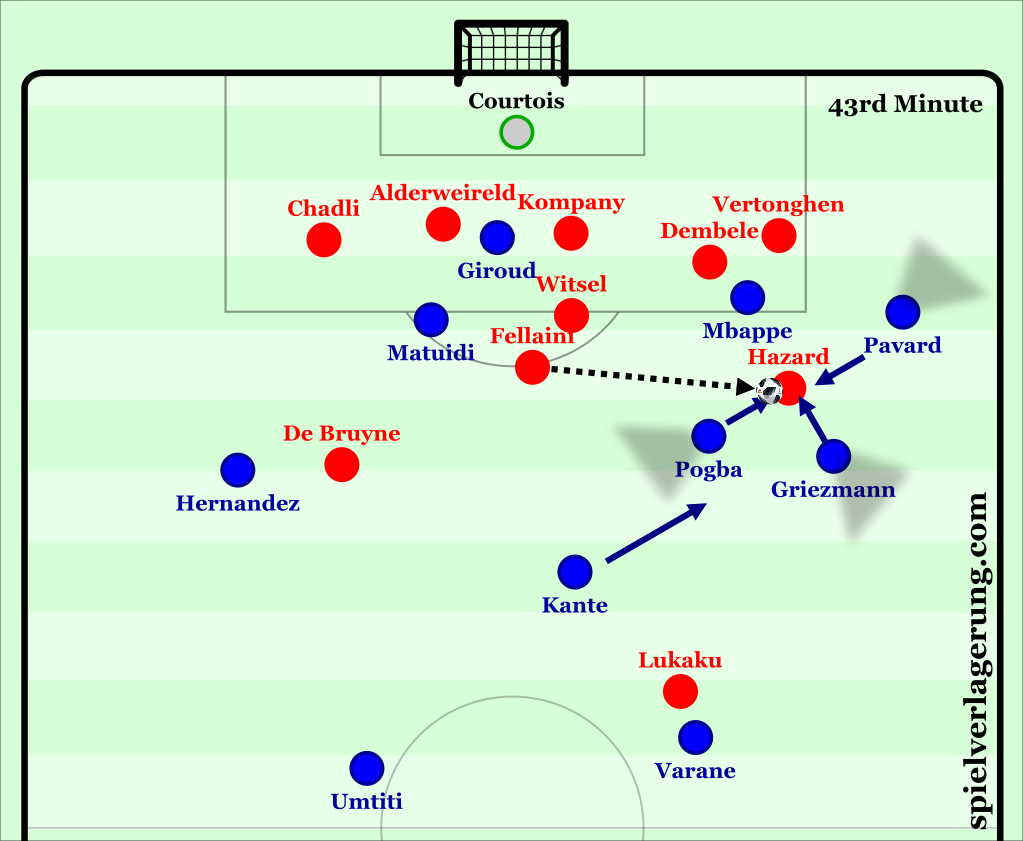
One example of France’s counterpressing, in which even the skillful Hazard can not make his way out of this situation.
フランスのカウンタープレスの例。アザールの技術をもってしても、この状況では逃れる事は出来ないでしょう。
Belgium were a step slow in providing the supporting angles from more distal players as the French initiated their counterpressure: too frequently did players have to dribble out of situations that are really hard to get out of on their own. The overall level of responsiveness was not high from this Belgium team in these transition phases, with only the front three being active in their movements to provide any sort of help. But France were savvy to apply heavy man orientations on the nearest Belgian player as the rest of the team counterpressed, so even if they were able to escape the first bit of pressure, France could anticipate the next pass and possibly intercept it or retrieve the ball if it there was a technical error.
フランスによるカウンタープレスに対してベルギーはサポートの提供が遅れていました。抜け出すのが困難な状況からドリブルで脱出しなければいけない場面が何度もありました。トランジションの局面ではベルギーの全体的な対応はあまりよくありませんでした。前の三人だけがサポートを行っていました。フランスはカウンタープレスの歳に最も近くにいるベルギーの選手に厳しくマンマークすることを得意としていました。もし彼らが一つ目のプレスから逃れたとしても、フランスは次のパスを予測できて、相手に戦術的なミスが有った場合にインターセプトやボールの回収を行うことができました。
In was in these pivotal moments that France created a palpable quality difference in terms of their team tactical implementations. While this match was interesting in that both teams counterpressed very high up the pitch, France were much superior in the organization and application not only in their attacking through Belgium’s initial pressure, but also in the defensive moments of the match that were crucial to limiting the Belgian star talent.
フランスはこの重要な瞬間に、チームの戦術的な習熟度の点で質の違いを生み出していました。この試合ではどちらのチームも高い位置でカウンタープレスを掛けているのが興味深い点でした。フランスの組織は優れていて、ベルギーのプレッシャーをかわす攻撃だけでなく、守備に切り替わった瞬間にもベルギーのスター選手に大きな制限を掛けていました。
State Change: France Gain the Edge
Minute 51 saw a fundamental shift in how the match was played, as Samuel Umtiti nodded away a corner kick to register the only goal of the match. Prior to that, there were a series of interesting developments that would’ve been interesting to see play out over a longer duration.
状況は変わり、フランスが優勢になる
この試合唯一のヌディディの得点がコーナーキックから生まれ、51分から試合に変化がおきます。この変化に先立って、暫くの間興味ぶかい展開がありました。
Belgium swapped the positions of Hazard and Fellaini more vividly at the start of the second half, bringing Hazard to the ten as discussed earlier. However, with Pogba intensifying his man-orientations onto Fellaini, Belgium’s attack appeared promising to get Hazard into more influential spaces. In addition, Hazard’s deeper positioning would better preoccupy Kante in France’s defensive structure, preventing his Chelsea teammate from chasing the ball at such a high rate, and thus limiting his potential influence on transitions and ball recoveries for his side.
後半開始からベルギーはアザールのポジションを入れ替えていました。アザールをより攻撃的な10番としてプレーさせるためにです。ポグバはフェライニに対するマンマークの強度をあげることは、ベルギーの攻撃により影響を与えるスペースにアザールが入り込める事を意味しています。さらにアザールが下がる事でフランスの守備組織のなかのカンテから先を取ることになります。高い確率でボールを追いかけることをカンテのチームメイトであるアザールは知っていたのでしょう。そしてカンテのトランジションに関わる影響とボール奪取に制限をかけることになります。
But after France’s goal, they began to possess the ball more defensively and enlist further help toward the defense of central zones, thus reducing some of the novelty of the Martinez adjustment battle. In the first hour, close chances that were of considerable difficulty, yet almost converted, were counteracted by Lloris. With the chips down, Martinez decided to alter his team’s strategy in hopes of squeaking in an equalizer after failing to do so for the first hour.
けれどもフランスの得点後、 彼らはより守備的なボール保持を始めて中央での守備をさらに強化していました。こうしてマルティネスが仕掛けた新たな策の効果をへらすことになりました。60分まで困難さを抱えたままで、いくつかのチャンスもロリスによって打ち消されました。開始からの1時間が失敗に終わり、追い込まれたマルティネスは同点においつく望みを託し、戦術の変更を決断します。
Belgium last hopes, France time management
With the introduction of Dries Mertens, Martinez altered Belgium’s structure from the 4-2-3-1 base found in the first hour of the game to a 3-4-3. Mertens entering for Dembele, pulled De Bruyne back to right centre midfield, and Chadli was pushed ahead to the right winger in the front three line. Fellaini and Hazard each found themselves in wide left spots, with Witsel now being the source of stability between them.
ベルギーの最後の希望。フランスの時間管理
メルテンスの投入の前に、マルティネスはこれまでの4-2-3-1から3-4-3へとシステムを変更していました。デンベレがメルテンスに替わり、デ・ブライネは右CMFになります。そしてシャドゥリは右ワイドへとポジションを上げました。フェライニとアザールはそれぞれ左サイドに居場所を見つけ、ヴィッツェルは全体のバランスを取っていました。
Considering the personnel, the roles of each of the players were somewhat of a surprise if it were a normal circumstance. Mertens on the outside right was tasked with whipping in crosses toward Lukaku and Fellaini, alongside Kevin De Bruyne having the same function from his inside right position. In the way that the first half saw the right side be a beacon of Belgian combination play, it suddenly converted to the source of directness for the whole team. The team was frantic and impatient with their decision making, with Martinez urging his players to relax at regular intervals. Their team identity was gone in a flash, suddenly blazing with long shots from centre backs and midfield movements carved in personal instincts rather than any sort of positional blueprint.
個人的な考えになりますが、 それぞれの選手の役割はもし平常状態なら多少驚くべきものでした。右サイドに開いたメルテンスは、ルカクとフェライニめがけてクロスを上げる役です。デ・ブライネは右インサイドからの同じ役割です。前半ではベルギーの連携プレーは右サイドから狼煙があげられていましが、突然チーム全体をダイレクト指向へと変化させました。チームはこの決断により落ち着きをなくし、いらだち始め、マルティネス監督は定期的に選手たちを落ち着かせようとしていました。チームとしてのアイデンティティはあっという間にに失われ、設計されたポジショニングというよりもむしろ個人の力に頼り、CBや中盤からロングボール攻撃が急に始まりました。
With France’s ever so disciplined unit in defense, Belgium’s team became more fragmented as injury time beckoned. As Giroud and co. focused more and more defensively, the likes of De Bruyne could not manage much of the ball in higher lines of the field, so they dropped back to retrieve the ball from the defense and playmak. This tendency exacerbated as time went on, eventually creating a sharp division between players attempting to remain in the positional blueprint and those abandoning the plan to do whatever they possibly could for themselves to get into the final.
フランスの守備が非常に統率がとれているため、ベルギーはアディショナルタイムが近づくに連れてばらばらになっていきました。ジルーはどんどん守備的になりデ・ブライネは高い位置でボールを管理することができなくなり、後ろに下がってDFからボールを受けたりゲームを作るようになりました。時間が進むに連れてベルギーのこの傾向は強まり、ポジショナルな攻撃をしたい選手と、決勝に進むために可能なことは何でもしたいという選手との間で、意識の差が生まれてしまいました。
France were able to absorb these moments of slight promise of the Belgians, without making any substitutions in the process. A puzzling change that Martinez made with around fifteen minutes left was taking off Fellaini for Carrasco, presumably to provide another dribbler to perhaps unlock the deep block after seeing the aerial efforts not work. With close chances on set pieces and some France defensive shifts, the final stretches of the game were standard and predictable given the strengths of Belgium’s physical players, the collective strength of France to not concede in the tournament once in the lead, and Martinez’s propensity to play more direct when his team is losing in elimination settings.
As for the French time wasting toward the end of the match, it has been an integral part of their campaign so far. Don’t hate the players, hate the game.
フランスはベルギーの見たほんの少しの希望を吸収してしまいました。交代選手を使うことも無くです。マルティネスは残り15分、フェライニに変えてカラスコという不可思議な交代をしました。おそらく空中戦ではなくドリブルによって深い守備ブロックを崩そうとしたのでしょう。セットプレーでの脅威がなくなったフランスは守備を変更します。ベルギーのフィジカルに強い選手をからすると、試合の締め方は基本的で予測可能なものでした。トーナメントに入ってから一度もリードを許さないフランスは集団としての強さがあり、チームとして準備が失われてしまったときにマルティネスはより直接的なプレーに偏るようになりました。
試合終了までのフランスの時間稼ぎは彼らのなずべき目的にとって不可欠です。選手を批判したり、サッカーの試合を嫌いにならないでください。
Conclusion
Belgium didn’t lack a Plan B. They weren’t good enough with their Plan A to beat France. The end.
総括
ベルギーにはプランBが欠けていました。プランAではフランスを倒すには不十分だったのです。それだけの事です。
